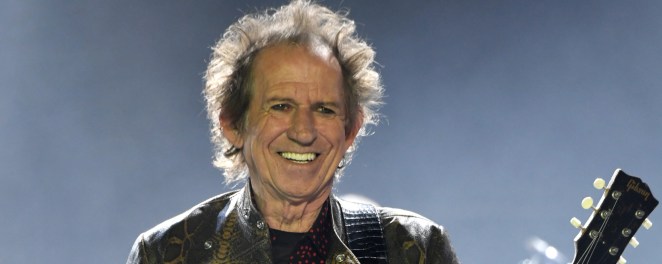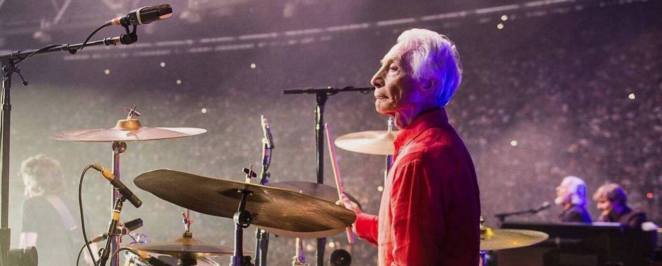Charlie Watts embodied jazz. He was “particular” and “pristine,” according to bandmate Ronnie Wood., and he often equalized detonations between Mick Jagger and Keith Richards. Watts was the soul of The Rolling Stones.
Videos by American Songwriter
“When he died my mind was blown,” said Wood. “We have the spirit of Charlie playing with us.”
Closing the band’s fourth-part Epix docuseries, My Life as a Rolling Stone, the final installment, dedicated to the life and times of Watts, presents the band’s longtime drummer’s life within the Stones along with personal revelations, told by a collection of friends, musicians, and his band mates.
“When you hear the intro to that it just becomes a physical reaction,” said Lars Ulrich of the opening drums on the Stone’s 1969 hit “Honky Tonk Women.” He adds, “It just overtakes your body.”
E Street Band drummer Max Weinberg talks about Watt’s fills in “Rocks Off” as a “musical conversation.” “That’s jazz, said Weinberg of Watts meticulous and technical drumming. “It’s so spontaneous.”
Keith Richards said Watts was from another place all together: America. “Charlie sounded like an American drummer,” said Richards. “He had that American feel. That’s what it was.”
Directed by Oliver Murray with narration by actress Sienna Miller, the docuseries closes on the Stones’ drummer, who died on Aug. 24, 2021 at the age of 80, his younger years and how he incorporated jazz into a rock band and transformed the Stones’ sound throughout his 58 years with them.
Here are 10 things My Life as a Rolling Stone uncovered about Charlie Watts.
1. The Keith-and-Charlie Connection
Richards and Watts worked in tandem. All Richards would have to do is look at Watts to know they were on to the right groove. “I’d usually look at Charlie and he’d just give me a grin because its clicking,” said Richards, “and it’s almost like you don’t even want to touch the strings because they’re doing it themselves and they’re hot.”
Sheryl Crow said that the marriage between Keith and Charlie created its own instrument. “The space they gave each other,” she said, “the ways the instruments fell was like a tapestry.”

By the mid-‘80s when Watts was struggling with an addiction to heroin and alcohol, it was also Richards who helped get him clean. “I took a lot of drugs late in life and didn’t do it very well,” admitted Watts. “I nearly lost a marriage and my life.”
Richards said it was Watts’s alcohol abuse that concerned him the most. “I told him ‘it’s just not you Charlie,’” laughed Richards. “The main thing really worried me about Charlie was the drinking. Some people are just perfect as they are. They don’t need stimulants. Charlie Watts didn’t need anything. He was immaculate. Immaculate Conception. Bless his heart.”
2. Jazz
The British Invasion of bands was flooded with acts deeply in love with blues and R&B and while the Stones immersed themselves in both, it was Watts’s infusion of jazz that set them apart. “For me the essence of what we do as a band and where Charlie comes from goes back to jazz,” said Wood.
Watts’ love for jazz gave the band the twist they needed to stand out, playing in the U.S. just three months after The Beatles took over America. “Jazz is a key component to rock and roll music,” said drummer Steve Jordan, who replaced Watts during The Rolling Stones most recent tour, following his death. “It’s not always talked about.”
As a teen, Watts would sneak downtown to Soho jazz clubs in London, popping into the Marquee and The Flamingo. “At 16 I used to stare at these people,” said Watts. When he later arrived to New York City for the first time, Watts immediately hit the Village Vanguard and Birdland, catching legends like Charlie Mingus and Sonny Robbins. “That was America,” said Watts. “I didn’t care about the rest of it.”
In the mid-1980s, as Watts was working on cutting his addictions, he returned to his first love: jazz. To help save the Ronnie Scott’s Jazz Club in London, Watts created a Big Band collective of jazz musicians in 1985 and shared proceeds from his residency to the club. Guests included everyone from future David Bowie collaborator Gail Ann Dorsey to newcomer, British saxophonist Courtney Pine as well as the more seasoned Jack Tracey or Cream bassist Jack Bruce.
Returning to jazz helped Watts kick his habits and return to the Stones, in 1989 around their Steel Wheels era, more invigorated.
3. Charlie Loved Charlie (Parker)
Childhood friend Dave Green who lived next door to Watts in post-war Wembley Park area of London remembers Watts being into bebop before him and his early love of jazz, particularly legend Charlie Parker.
“His love of Charlie Parker was absolutely immeasurable,” said Green. It sounded like music from outer space. It transported you to another world.”
In 1991, Watts organized the Charlie Watts Quintet, featuring vocalist Bernard Fowler. A tribute to Charlie Parker, the band released four albums together.
4. Chico Hamilton and Learning the Drums
“The first drummer I wanted to be, ever, was Chico Hamilton,” said Watts. Foreststorn “Chico” Hamilton was an American jazz drummer and bandleader, who worked with the likes of Gerry Mulligan, Count Basie, Lena Horne, and Lester Young.
When Watts was young he would often play beats on the family table with a piece of wood or knife and fork. He later took the neck off a banjo and played the skin of the instrument with a set of brushes before his parents bought him a drum set from a guy who played at a nearby pub.
“We bought him his first drum set for Christmas when he was 14,” said Watts’ mother Lillian in an excerpt read by Green. “It cost 12 pounds. He took to it straight away and often used to play jazz records. The neighbors were good. They never complained.”
Green laughed, “I was the neighbor. Fantastic.”
By the time he was 18, Watts joined his first band The Joe Jones All-Stars and Green shared the very first recording of his friend playing drums in the documentary during a gig on Aug. 21, 1959 at the Edgeware Jazz Club. “You can hear his great swing,” said Green, “even there.”
5. When the Music’s Over…
Watts was never “rock star” material. He never destroyed hotel rooms or threw TV sets out windows, and there were no groupies, only his wife of 57 years Shirley. “When the music stopped I wish I could’ve turned it off,” said Watts. “I hated it. I hated being chased by girls and all that. It used to really embarrass me. It’s always been that’s what the Rolling Stones do, not me.”
An “accidental” rock star, in a sense, Watts always had an ambivalent relationship with stardom but his calm and composed state is what set him apart from from the rest of the Stones and make him the backbone of the band.
“I think the Rolling Stones are great,” said Watts, “but I kind of don’t see me in it somehow.”
6. Charlie Drew Hotel Beds
Watts drew every hotel bed he slept in and other details of his surroundings while on tour with The Rolling Stones, beginning some time the 1960s.
“It started in ’60-something and it was something to do,” shared Watts. “It’s a diary and now I can’t miss one because it’s ruining a day of.”
After seeing the details in Watts’ “tour” books of still life line drawings and self-portraits, he urged his bandmate to release them.
“I always said to him ‘you should release these,’ and he said ‘no one wants to see this,’” said Wood. “I said ‘they do Charlie. Its a real eye into your world.’ He totally underestimated his power as a person.”
7. O.C.D.
Watts would often avoid cracks in sidewalks or walk up and down stairs in a certain way. Wood called his bandmate “particular” and “pristine” right down to the way he folded his socks and other clothes, placing tissue paper in between all shirts, jackets and other garments. On occasion he can even be seen picking up a piece garbage off the stage.
When it came down to it, Watts liked a controlled environment and would even ban hotel maids from entering into his room. These particularities transferred to his meticulous playing and his pre-show ritual. His dressing room, called the “Cotton Club,” is where Watts would listen to Duke Ellington before going on stage with the Stones.
8. The Charlie Watts “Drum Museum”
In an undisclosed location is where Watts housed a treasure trove of drum kits, ones belonging to some his all-time favorite drummers, including Tony Williams, and one Kenny Clark once gave to Max Roach and Joe Morello from his time in the Dave Brubeck Quartet. He even owned a Charlie Parker “Bird” horn case.
Watts often told Green that he some day wanted to open a drum museum.

9. A Bespoke Gentleman
Always the dapper one, Watts was generally covered head-to-toe in a tailored suit. “I think the look of rock and roll is a bit shabby,” said Watts, “but that’s me.”
Never dressing the part of the rock star, instead Watts looked more like a jazz musician in a rock band.
Often playing drums in his suit, Watts was an avid customer of bespoke suits, shirts, shoes, gathering pieces from his favorite British tailor Huntsman Suits.
“I’ve got a campaign,” joked Watts. “I’m saving the bespoke suit industry single handedly.” He added, “I have this disease. I see a swatch and I have to have a jacket or something.”
It was no secret Watts liked the finer things in life, from his lavish estate in Devon, England to his Victorian-era looking tea cup and saucer marked “Charlie’s Touring Tea Set” and the early 20th century Lagonda car parked outside his home, which he never drove.
When it came to his fashion, Watts veered toward more classic 1940s-‘50s lines in design, like his father. “I live in TCM [Turner Classic Movies] world.”
10. The Coat Hanger
Like a drawing out of one of his touring journals, Watts always had a coat hanger, like one you would get in a hotel room, near his drum kit where he would hand his jacket. The hanger had an “open” and “closed” sign that Watts used for “business.”
“When Charlie was playing the drums it would say ‘open’ and when he wasn’t it would say ‘closed,’” said Jagger. “And the only person who changed it was Charlie.”
(Photo by Gary Gershoff/Getty Images)
